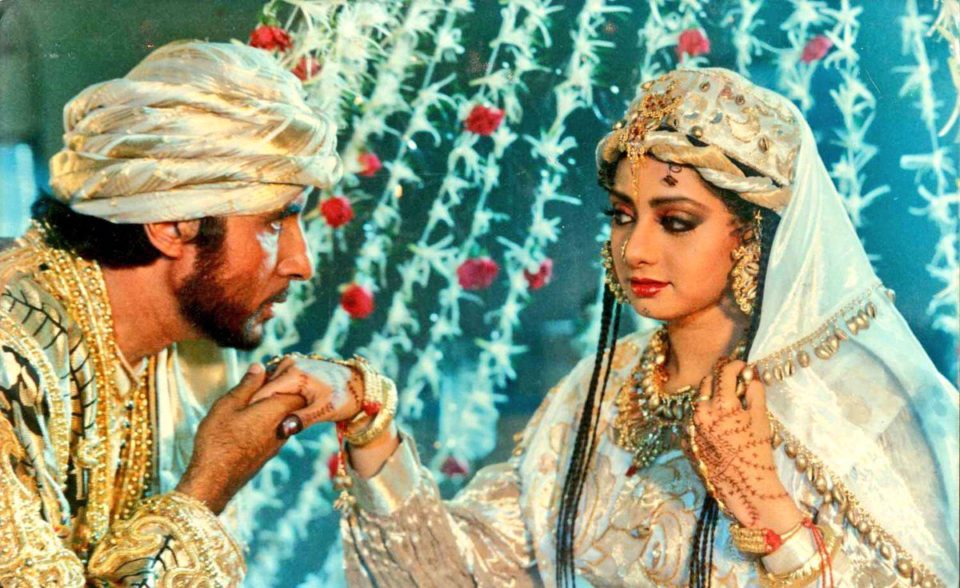#RSFlashback – Thirty Years Ago This week, ‘Khuda Gawah’ Released and the Film Went Way Beyond India
It laid the foundation for modern epic dramas and their equally epic soundtracks
Once upon a time (well, 30 years ago this week, to be precise), an epic film was released. Called Khuda Gawah, it featured the two biggest stars in Bollywood at the time, Amitabh Bachchan and Sridevi. The film’s grandness was visible in every frame, from the lavish costumes to the cinematography that captured the true beauty of Kabul and Mazar-i-Sharif in Afghanistan. It should be noted that the movie contains some of the most memorable visuals of the war-torn nation. And the Afghan President at the time, Mohammad Najibullah, was such a fan of Bachchan that he provided security detail from the Afghan Air Force to protect the cast and crew during the filming in 1991.
At a time when many conversations are being had about pan-Indian films, Khuda Gawah was not only scaled for the entire Indian market, but it ended up becoming a successful mini-series in neighboring Pakistan, too, and to date remains one of the most successful Indian films ever in Afghanistan.
Director Mukul S. Anand was far ahead of his time. He brilliantly cast Bachchan against Sridevi, who essayed two roles in the film, the only time a female actor has ever played a double role in a Bachchan flick. Sridevi was arguably the bigger star when the film released in 1992, but their pairing was so beloved that it made sense to bring the two powerhouse performers together again for the third time.
Of course, Anand knew well before any chatter of ‘pan-India’ to cast Telugu star Nagarjuna as the second male lead, while adding Shilpa Shirodkar for the younger-star quotient. With a supporting cast including heavy hitters like Danny Denzongpa and Kiran Kumar, the film’s performances were bound to be first-rate.
And as for the music, the mastermind duo of Laxmikant-Pyarelal were roped in as usual. The twosome knew their way around grand orchestral arrangements, but here, they got to incorporate a little Sufi magic into their normal style to create an equally unforgettable melodious soundtrack. “Tu Mujhe Kabool” became a blockbuster duet for Mohammed Aziz and Kavita Krishnamurthy while the solo version by Lata Mangeshkar also became a rage. The emotional “Tu Na Jaa Mere Badshaah” almost became the template for the entire soundtrack of Bachchan’s son’s debut film, Refugee, years later while the fun “Mere Watan Mein” showcased the energy Alka Yagnik would continue to mesmerize us with throughout the rest of the 1990s. It should also be noted that Khuda Gawah was the first Indian film to use surround sound, furthering the lavishness of the film’s presentation even more. The movie worked in a big way at the box office, going on to become the third-highest grosser of the year and garnering countless nominations at the year’s award shows.
In many ways, Khuda Gawah was the real acid test for the reach of the film’s superstars, and also for Indian cinema itself. What many realized (and of course failed to replicate for too many years) was that universal stories told on a grand scale with big actors, impressive production and sing-along music could cross over and result in massive commercial appreciation.
Khuda Gawah hasn’t gotten the long-term love and respect it deserves. Before Ashutosh Gowarikar and Sanjay Leela Bhansali redefined the epic drama or S.S. Rajamouli made us wonder about the pan-India formula, Anand created a critically acclaimed world where commerce and art came together on a massive scale and the audience came out in droves, sang along, whistled and even rooted for a female heroine in a way we’ve rarely seen in the past 30 years.
At a time when films and their music are becoming less and less intertwined, Khuda Gawah is a beautiful reminder of a period when the two worked so well together – almost as if they couldn’t work without the other. It’s saying something when the songs themselves narrate the crux of the film’s story, so as to always keep us connected… no matter what.








